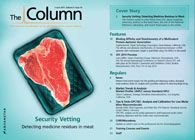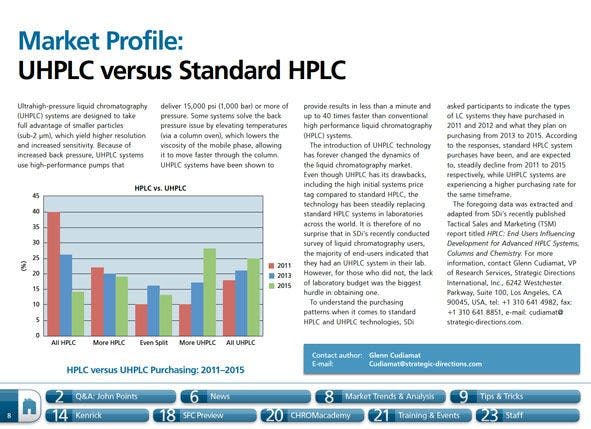Illicit drug breath profiling
Scientists from the Karolinska Institute (Stockholm, Sweden) have taken a step closer towards the development of portable illicit drug testing using exhaled breath.1 The study published in the Journal of Breath Research details the use of liquid chromatography?mass spectrometry (LC-MS) to analyse exhaled breath of patients recovering from acute drug abuse.
Scientists from the Karolinska Institute (Stockholm, Sweden) have taken a step closer towards the development ofportable illicit drug testing using exhaled breath.1 The study published in the Journal of Breath Research details theuse of liquid chromatography–mass spectrometry (LC–MS) to analyse exhaled breath of patients recovering from acutedrug abuse. This opens up the possibilities of roadside, criminal justice, clinical, and workplace drug abuse testing.
Lead author Olof Beck told The Column that the main aim of the investigation was to build on previous studiesto obtain good detectability for a broad range of drugs. His frustration with working with saliva and the associated analytical problems led him to try and use exhaled breath. Beck said: “People always asked me why is drug testing notas easy as alcohol testing (by breath). We decided to try it and were lucky.”
Currently, urine and blood are most commonly sampled to test for the abuse of illegal drugs. This can be invasive,uncomfortable, and a long analysis process. In addition, it is sometimes impossible in some situations; for example, onthe roadside. The challenge of using exhaled breath samples lay in collecting aerosol particles selectively with sufficientsensitivity, according to Beck.
The exhaled breath samples were collected from a group of 47 patients using a specially designed commericallyavailable mask. The mask had a specific filter to trap non-volatile microparticles that carry narcotic molecules.The molecules were then analysed by LC–MS that had been optimized for maximum sensitivity. The specificcompounds that were tested for were methadone, amphetamine, methamphetamine, 6-acetylmorphine, morphine,benzoylecgonine, cocaine, diazepam, oxazepam, alprazolam, buprenorphine, and tetrahydrocannabinol. The resultswere compared with analysis of urine and plasma samples to validate the method.
Beck told The Column that in the future the research group will work towardsdeveloping MS sensitivity for the very low level of aerosols available for analysis,as well as improving detection times.
Reference
1. O. Beck et al., Journal of Breath Research, DOI: 10.1088/1752-7155/7/2/026006 (2013).
This story originally appeared in The Column. Click here to view that issue.

Characterizing Plant Polysaccharides Using Size-Exclusion Chromatography
April 4th 2025With green chemistry becoming more standardized, Leena Pitkänen of Aalto University analyzed how useful size-exclusion chromatography (SEC) and asymmetric flow field-flow fractionation (AF4) could be in characterizing plant polysaccharides.
Investigating the Protective Effects of Frankincense Oil on Wound Healing with GC–MS
April 2nd 2025Frankincense essential oil is known for its anti-inflammatory, antioxidant, and therapeutic properties. A recent study investigated the protective effects of the oil in an excision wound model in rats, focusing on oxidative stress reduction, inflammatory cytokine modulation, and caspase-3 regulation; chemical composition of the oil was analyzed using gas chromatography–mass spectrometry (GC–MS).











